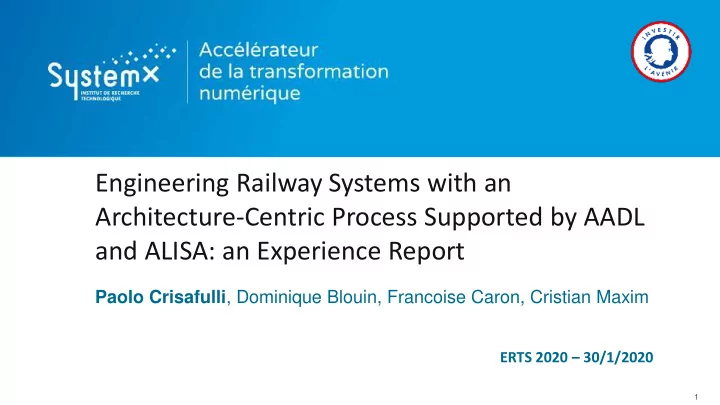

Engineering Railway Systems with an Architecture-Centric Process Supported by AADL and ALISA: an Experience Report Paolo Crisafulli , Dominique Blouin, Francoise Caron, Cristian Maxim ERTS 2020 – 30/1/2020 1
Context: ETCS on-board and EVC ERTMS: European Rail Traffic Management System ETCS: European Train Control System EVC: European Vital Computer 2
AADL - Architecture Analysis and Design Language 3
Our journey with AADL Expressivity: TMR Performance TMR Design Model Analyses: RT Traceability and Requirements Analyses (Free text) requirements Model verification Verification Structured Analyses Requirements Model Prototyping Tests Traceability Model refinement Prototype Profiling / Scheduling Budgets 4
AADL Model: Software 5
AADL Model: Hardware 6
AADL Model: Bindings 7
Some requirements for the EVC Focus on performance requirements verification: Latency < 300 ms Incoming messages <= 1000 msg/s Safety and availability: THR of 0.67 x 10-9 dangerous failures/hour • • 2oo3 (aka TMR) design o Verify some 2oo3 design constraints Same threads shall run on each board • Boards shall be of the same model • Design rules (reusable good practices) All input and output ports, physical or logical, shall be connected. • • All threads shall be periodic 8
Our journey with AADL Expressivity Performance TMR Design Model Analyses Requirements Requirements Analyses (Free text) traceability and Model verification Verification Structured Analyses Requirements Model Prototyping Tests Traceability Model refinement Prototype Profiling / Scheduling Budgets 9
ALISA - Concepts and organisation Organisation Goals AADL Package Property Set Verification plan Assurance Case Stakeholders Requirements Requirements Activities AADL classifier Assurance Plan(s) Assurance Task(s) Requirements Resolute claim Osate plugins Java code Junit test plan AGREE Requirements Model Verification 10
EVC Requirements - ALISA 11
Iterative incremental approach with AADL Expressivity Performance Design Model Analyses Requirements Requirements Analyses (Free text) traceability and Model verification Verification Structured Analyses Requirements Model Prototyping Tests Traceability Model refinement Prototype Profiling / Scheduling Budgets 12
Towards an agile engineering process This tooling works fine for standalone development How do we scale in requirements and team size ? Incremental development (versions history) • Non regression • Keep track of verification results and KPIs (Re)use the continuous integration paradigm Define ALISA requirements for major design and implementation choices KPI Charts 13
Building blocks Osate/ALISA/AADL Inspector AADL parsing, analysis and verification platform Git/Repo Jenkins Versioning system for the Continuous integration comprehensive source of all Triggers verification check on any artifacts: change to the artifacts ▪ Requirements ▪ Models and Code ▪ Verification activities ▪ Dockerfiles Docker Container platform Configuration management of the development, build and test environments 1 4
Non regression: Verify requirements, design choices, implementation choices Requirements EVC response time shall be < 300 ms Design TMR: all functions shall be redounded Implementation Divide pipeline period into 3 subperiods
Keep track of the KPIs 16
How it looks: build history 17
How it looks: verification and performance history 18
Conclusions A showcase of how AADL and ALISA can support an agile architecture-centric engineering process for a typical embedded system in the railway domain: The continuous verification maintains the design within the solution space shaped by the set of • requirements • The KPIs computation and charting qualify, in terms of performance, its evolution and alternatives over time. ALISA is currently still under stabilization, hence its usage cannot be recommended for an engineering team facing hard delivery deadlines. Nevertheless, this experiment illustrates where the AADL ecosystem of companion languages and development environments is standing, opening the way to agile engineering of highly constrained systems, such as critical systems requiring a certification process. Additional work: link to the overall system engineering process, SysCon 2020 19
Thank you! 20
Recommend
More recommend